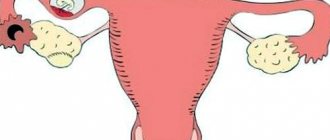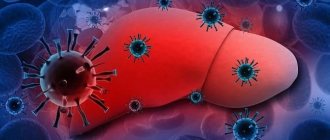Sharp pain in the lower abdomen during pregnancy does not occur normally. This is a symptom of the development of a pathology, accompanied by complications without timely treatment. If a woman’s health worsens, call an ambulance.
How long have you had this pain syndrome?
- A few days (25%, 569 Votes)
- First day (21%, 479 Votes)
- Several months (12%, 273 Votes)
- Week (10%, 232 Votes)
- Several weeks (10%, 229 Votes)
- About a month (8%, 188 Votes)
- Chronic form (7%, 154 Votes)
- About a year (6%, 125 Votes)
Total voters: 2 250
Loading …
Use search Are you having a problem? Enter “Symptom” or “Name of the disease” into the form, press Enter and you will find out all the treatment for this problem or disease.
What causes sharp pain in the lower abdomen during pregnancy?
Pain syndrome with acute symptoms does not occur for physiological reasons.
When the patient is admitted to the hospital, she is examined, laboratory and instrumental tests are performed, and the following gynecological causes are identified:
- premature birth or miscarriage;
- increased uterine tone;
- a sharp push of the child with a change in body position in the wrong direction (breech presentation);
- ectopic pregnancy – attachment of a fertilized egg to the fallopian tubes (an inflammatory reaction and bleeding gradually form).
It is possible to develop diseases not related to pregnancy. You will need to consult doctors of narrow specialties, for example, a gastroenterologist, an infectious disease specialist.
Looking for damaging factors, diseases:
- exacerbation of sexually transmitted infections - chlamydia, ureaplasmosis;
- increased nephritis, pyelonephritis, urethritis, and other pathologies of the urinary system;
- damage to the musculoskeletal system in the hip area - bones, muscles, ligaments, tendons, joints;
- pinching, damage, inflammation of nerve tissue (the sciatic nerve is often affected);
- pinching of a vessel, impeding the normal flow of blood to the internal organs.
Examination of a woman during pregnancy is difficult. X-rays and MRIs cannot be performed. It is impossible to identify areas of bone damage. Research is done in extreme cases.
It is allowed to use analysis of biological fluids, determination of liver tests, and bacteriological culture. An ultrasound of the pelvic and abdominal organs is required. They determine whether there is any damage to the uterus or baby.
They correct the painful condition that has arisen in the early stages, eliminating the risk of complications. Acute pain syndrome is relieved immediately, but the use of analgesics and painkillers is prohibited.
Diagnostic methods
If a woman has pain in the lower abdomen, the doctor must first consider the gynecological cause of the unpleasant symptoms. For this purpose, a cytological or urogenital examination of vaginal tissue may be required, which will identify pathology at an early stage.
If the gynecological cause is confirmed, then the next stage of the study may be ultrasound, colposcopy, cystoscopy, or hysteroscopy. Sometimes hysterosalpingography or laparoscopy is required. Diagnostic methods for pain in the lower abdomen in the early stages also include standard procedures for collecting urine and blood tests.
Single acute pain in the lower abdomen during pregnancy
When the fetus becomes large, its movements become difficult. This is especially true after 30 weeks. Active movement is observed, bringing discomfort to the expectant mother.
Cramping attacks may appear and cease over time. Your further well-being is monitored to ensure that the condition does not reoccur.
If this is a one-time action, the problem is active movement. If you experience frequent, severe discomfort, contact your doctor at a medical facility.
Patients characterize the pain as acute, moving from the lower abdomen to the pubis and tailbone. If the attack occurs again, an examination is carried out. The treatment method depends on the cause that caused the changes in the body.
Most medications are not recommended during pregnancy; bed rest and constant rest are often prescribed. If a woman has a large fetus, use the knee-elbow position.
What can hurt in the lower abdomen?
There are many organs in the lower part of the human torso. Each of them can cause pain. The main, primary task in treatment is to determine the source of inflammation. They can be:
- stomach;
- appendix;
- intestines;
- reproductive organs or genitourinary system;
- spleen.
Sharp pain in the lower abdomen
More often, sharp painful attacks are caused by irritable bowel syndrome; cutting discomfort has varying degrees of intensity (from mild to acute), often becoming stronger after eating. The disease is accompanied by the following symptoms:
- feeling of incomplete bowel movement;
- bloating;
- constipation;
- flatulence;
- diarrhea;
- “lump in throat” when swallowing;
- muscle pain;
- nausea.
Cramping pain in the lower abdomen
Such sensations are usually caused by obstruction of the colon. It may occur due to a failure in the movement of its contents through the intestines. The main symptom will be cramping pain, bloating, and less commonly:
- vomit;
- loss of appetite;
- absence, stool retention.
Contractions usually occur every 15 minutes. If you do not pay attention to these symptoms, then after 3 days they will disappear, but this should alert the patient even more. Such changes may indicate a cessation of intestinal motility, which can lead to intoxication and death. In such a situation, immediately consult a doctor at the hospital.
Pain in the lower abdomen on the right
In most cases, inflamed appendicitis creates discomfort in the right side. Initially, the pain is spread throughout the stomach area in the middle, but later it appears in the lower abdomen and is concentrated on the right. The pain intensifies when turning over from one side to the other, walking or coughing. Over time, tension will arise below, which is an important signal to go to the hospital. The person will constantly feel sick, the temperature and blood pressure will rise, there will be an appetite disorder, and loose stools.
Pain in the intestines on the lower left side
Often people, when meeting with a doctor, say that they have pain in the left lower abdomen. This localization of discomfort may indicate a number of diseases:
- Irritable bowel syndrome. The cause of the disease is unclear, but many argue that stress causes it. It appears in men and girls of any age, but is more common in women over 30. Pain in the intestines on the lower left side is chronic and can be accompanied by constipation, flatulence, and diarrhea.
- Crohn's disease can cause pain in the left lower abdomen. This is an inflammatory process of the gastrointestinal tract that occurs in the descending colon.
- Hirschsprung's disease. This is a hereditary pathology that boys are more susceptible to. The disease is characterized by the absence of areas of innervation in limited, individual areas of the large intestine.
How classical music can help
When conception occurs, the woman becomes anxious. She is worried about the upcoming birth and the health of the child. This leads to pain in different parts of the body.
They relax, reducing psycho-emotional stress. Listen to classical music. It should be slow, melodic, relaxing. It is not recommended to use fast pieces of music; listening to them increases the pulse, heart rate, and changes in mood.
This leads to the release of adrenaline, which worsens the condition. Over time, the patient will learn to control the psychological background, and then improvements will occur.
What does dull, pulling, point or cutting pain in the abdomen indicate?
Stomach pain during pregnancy is due to changes in the body, in organs associated with hormonal changes, changes in the position of internal organs, and obstetric pathologies.
Many types of these sensations do not pose a threat to the health of the mother or the condition of the fetus. Others cause significant harm and even death to the woman and the unborn child.
Pain is a reaction of the nervous system to stimuli. A symptom of many diseases, including obstetric pathologies during pregnancy. A pregnant woman experiences hormonal changes and a restructuring of many systems. They are also accompanied by this feeling.
If discomfort and pain occur, it is better to consult with your doctor about the nature of these sensations and appropriate treatment. During pregnancy, a woman is responsible not only for her own health, but also for the health of the baby.
Nature has determined that the mother’s body tries to protect the fetus from all negative influences. A plug formed from mucus in the cervix prevents pathogenic microorganisms from entering.
Umbilical cord nutrition is formed in such a way that harmful chemical compounds do not enter the fetus. The uterus itself protects the child from external mechanical influence.
At the same time, during the period of bearing a baby, the woman herself may regularly experience pain of varying intensity and nature. Each type of discomfort indicates the presence of different pathological conditions, with the exception of harmless obstetric ones associated with changes in the maternal body and preparation for childbirth.
Based on the nature, intensity of pain, and gestational age, we can talk about how dangerous the condition is.
For example, pulling, extending to the lower back and groin, may indicate a risk of miscarriage. An additional sign of the condition will be the presence of bloody discharge.
In this case, you should immediately seek medical help and undergo an examination. If you delay visiting a doctor, the frequency of contractions will become more frequent and spontaneous miscarriage will occur.
Uterine tone is dangerous regardless of how early it was diagnosed. The fetus may experience a lack of oxygen and incoming nutrients. The woman feels a sharp pain like contractions. The solid state of the uterus and lower abdomen is recorded.
In case of injury, late toxicosis, or stress, placental abruption may occur. The condition is accompanied by acute pain in the lower abdomen. Often there is internal bleeding without external manifestations in the form of discharge. Urgent hospitalization and surgical intervention are required. Without help, death will occur.
Cramps accompanied by dizziness at five to twelve weeks can be a symptom of an ectopic pregnancy. For a number of reasons, the egg was unable to enter the uterus and became embedded in the fallopian tube.
As a result of the rapid growth rate of the fertilized egg, severe pain occurs. The woman is sent for an ultrasound examination. An operation to terminate the pregnancy is prescribed. Lack of medical care will result in death for the pregnant woman.
A number of non-gynecological problems also contribute to the occurrence of unpleasant sensations in the lower abdomen:
- Disruption of the gastrointestinal tract. Additional symptoms: bitterness in the mouth, tingling in the lower abdomen, heartburn.
- Inflammation of the bladder and urinary tract. Symptoms: discomfort and burning when urinating, increased frequency of the urge to urinate, increased body temperature.
- Seasonal colds. They are accompanied by headaches, nasopharyngeal congestion, aching bones, and fever.
- Inflammation of the appendix (appendicitis). An acute condition in which severe vomiting occurs, weakness, and a strong increase in temperature are detected. Surgery is used to remove the inflamed area. This procedure is safe for a pregnant woman. Abdominal laparotomy appendectomy is used if peritonitis is suspected and less invasive laparoscopy is used if there are no signs of peritonitis. A course of rehabilitation therapy is prescribed.
It is possible to diagnose the pathology based on additional symptoms. Treatment should be supervised by medical professionals. It is prohibited to take pharmaceutical drugs on your own. If you aggravate your own condition through inept actions, this will inevitably affect the child’s development.
Cystitis
Cystitis is a pathology in which the inflammatory process affects the walls of the bladder. The disease is several times more common in women than in men. This is due to the structural features of the female genitourinary system, including a short and wide urethra, which greatly facilitates the penetration of infections into the urinary tract.
Cystitis in women
The pathology is characterized by frequent urination, with the urge to empty the bladder appearing every 15-30 minutes. Urine has a cloudy dark color, it often contains a small amount of mucus or pus, and there may be blood inclusions.
With cystitis, the patient feels cutting pain in the pelvic area above the pubis, which sharply intensifies when trying to urinate. Warmth helps relieve pain: taking a hot shower or applying a heating pad to your stomach.
Signs of cystitis
Hyperthermia signals the presence of an inflammatory process. Patients have low-grade fever. In severe cases, the infection also affects other organs of the excretory system, leading to the development of urethritis or pyelonephritis. In this case, the patient’s temperature may rise to 39-39.5°C, and the woman’s general condition sharply worsens: severe weakness, cephalalgia, nausea, lower back pain, etc. occur.
Attention! Pyelonephritis is an inflammatory process in the tubular system of the kidneys. This condition can lead to the development of a number of complications, so it requires urgent medical intervention.
Condition of the kidney with pyelonephritis
Patients with cystitis are constantly bothered by the feeling of an incompletely emptied bladder, pressure in the pelvic area, cramps and spasms. Without treatment, a woman may develop urinary incontinence.
When do you need to see a doctor urgently, and which doctor will help?
Cases of pain where medical intervention cannot be avoided:
- Cramping attacks of a pulling nature (especially in the first trimester of pregnancy) - you need to immediately seek help. There is a high risk of miscarriage or placental abruption. The presence of mucous discharge mixed with blood is a reason to call an ambulance for immediate hospitalization of the patient.
- Shingles with a return to the lower back in the presence of a burning sensation at the time of urination - signs of the development of pyelonephritis. Long-term treatment may be required. Signs of illness should be reported immediately.
- In the later stages, accompanied by contractions and increased uterine tone - a sign of premature birth.
Regardless of the stage of pregnancy, the appearance of bleeding from the vagina with or without pain - you should definitely call an ambulance.
Consulting a pregnant woman and caring for the patient during pregnancy is the responsibility of the local obstetrician-gynecologist. They work in district antenatal clinics.
You can get an appointment with them in the following ways:
- through an electronic appointment system;
- by calling the registration number of the medical institution;
- Some consultations retained the journal recording system.
If the pain is not associated with the course of pregnancy and does not affect the development of the fetus, then you need to contact your local physician. It is important that treatment is selected taking into account saving the life and health of the mother and child.
Cervicitis
Cervicitis is a disease that leads to severe inflammation of the cervical canal. The cervix is a natural barrier that prevents pathogens from entering the woman’s reproductive system. In some cases, for example, when the mucous membranes are damaged, microorganisms enter the tissue of the cervical canal and provoke the development of infection.
There are two types of cervicitis:
- Exocervicitis is inflammation of the outer segment of the cervix.
- Endocervicitis is a lesion of the inner mucous layer of the cervical canal.
Inflammation of the cervix from the inside
A patient suffering from cervicitis has the following complaints:
- cutting pain in the lower abdomen and vagina;
- discomfort in the lumbar region;
- itching in the genital tract;
- increased discomfort when urinating or during sexual intercourse;
- the appearance of bloody discharge from the vagina after coitus;
- petechiae on the mucous membrane of the genital organs;
- unpleasant odor from the vagina.
Attention! Often recurrent chronic cervicitis provokes hyperplasia of cervical tissue, the development of erosion and the spread of the pathological process to the body of the uterus and fallopian tubes.
Video: Cervicitis in women
Depending on the type of infectious agent, patients are prescribed antibacterial or antiviral agents: Valtrex, Acyclovir, Ofloxacin , etc. After stopping the acute inflammatory process, local treatment of the pathology is carried out: the genital tract is treated with a 3% solution of dimethyl sulfoxide or 1-2% solution of chlorophyllipt .
Top medications to reduce abdominal pain during pregnancy and breastfeeding, painkillers
Painkillers are not advisable during pregnancy. Especially in the first months, when the main formation of organs and tissues of the future person occurs. However, the process of experiencing discomfort caused by constant negative factors also does not bode well.
Before purchasing analgesics, consultation with a specialist is required. It is advisable to try non-pharmaceutical ways to cope with discomfort.
The least dangerous drug is Paracetamol. Suitable for use throughout the entire gestation period. Toxic components are in minimal concentration and are quickly excreted in the urine.
Ibuprofen is a non-steroidal anti-inflammatory drug. Prescribed with caution during the second trimester. Contraindicated for the first and third trimester. Use may cause a number of dangerous side effects. If your condition changes slightly for the worse while taking an analgesic, you should inform your doctor.
Indomethacin also belongs to the group of non-steroidal anti-inflammatory drugs. It is subject to the same restrictions as Ibuprofen. If taken continuously, there is a risk of damage to the child's kidney function.
For the first two trimesters, it is permissible to use creams and ointments based on:
- Diclofenac.
- Ketoprofen.
- Ketorolac.
In the third trimester, you can only use local products based on herbal ingredients. It is forbidden to apply them if they contain bee or snake venom.
Ointments with an irritating effect that stimulate increased blood circulation can also have a negative effect. There is a risk of developing uterine tone and high blood pressure.
The most powerful painkillers are classified as narcotic substances and are prohibited for free sale. Their use occurs only in a hospital with extremely severe pain. These are drugs based on morphine and codeine.
The list of chemical compounds for pharmaceutical use during pregnancy is extremely limited. Before you start taking it, you should read the instructions for use in detail and strictly follow the manufacturer’s recommendations on dosage and method of use.
It is important to familiarize yourself with the provisions on common side effects and contraindications.
It is possible to use folk and non-traditional methods of getting rid of suffering. For example, yoga for pregnant women, acupuncture, light massage, aromatherapy. Traditional methods are also used. But their use also needs to be discussed with a specialist.
Preventive measures to avoid abdominal pain
The basis of prevention is the correct lifestyle of a pregnant woman:
- No stress factors. The mental state of the mother is the key to the health of the child. The fetus inside a woman reacts sensitively to changes in the mother’s emotional background. He is not able to recognize the causes of depression or fears, but he is aware that adverse events are occurring. If the mother is very worried, there is a risk of pathological changes during the formation of the future person. Neurological and psychological problems are possible.
- Elimination of physical fatigue. Pregnant women are not recommended to attend training regularly. During active sports, blood pressure levels increase noticeably. This will provoke the development of uterine tone, which will inevitably lead to adverse consequences. You can go for walks in the fresh air.
- Properly designed diet and nutrition schedule. It must be balanced. You should not consume fast food products or preservatives; it is recommended to reduce the amount of tea and coffee. It should consist of vegetables, fruits, animal and plant protein. It is worth taking vitamins prescribed by a doctor for those who are pregnant. Weight control is required, since the percentage of subcutaneous fat outside the normal range negatively affects the functioning of the cardiovascular system and gastrointestinal tract. The feeding processes of the fetus are disrupted. With rapid weight gain, nutritional correction and a special diet may be prescribed. Excess weight contributes to decreased activity, bad mood, and additional pain in the back and joints. Make sure there is no overeating.
- Maintaining a sleep and rest schedule ensures that a woman is highly active. She does not feel tired and overwhelmed, which means she has a positive morale.
- Regular observation by an obstetrician-gynecologist according to the established schedule, passing mandatory tests, compliance with received medical recommendations. Undergoing developmental ultrasound examinations and other diagnostic measures.
- Tracking the development of chronic pathologies that were diagnosed before pregnancy.
- Prompt treatment of colds, bacterial and viral diseases acquired during pregnancy.
- Eliminate all bad habits, such as alcohol, smoking, and drug use. Failure to comply with this rule results in a developmental delay in the baby.
- Monitoring blood pressure for hypertension (high blood pressure) or hypotension (low blood pressure). Monitor your sugar levels if you are diagnosed with diabetes.
- Do not take a hot bath or shower, or a contrast shower. A sharp change in ambient temperature threatens a rise in pressure and disruption of the cardiovascular system.
Compliance with these rules will ensure comfortable and proper pregnancy. The pain will be considered obstetrically safe. But even if you follow all the recommendations, you need to carefully monitor your own condition and, if there are reasons, seek medical help.
What to do for lower back and abdominal pain
Pain in the abdomen or lumbar region is a signal of a failure (the onset of a disease, a “breakdown” in an organ or surgical intervention).
All of the considered causes of pain are associated with painful disorders in important systems of the body for life.
We ourselves cannot get rid of such pain. Professional diagnosis and treatment are needed. This is the prerogative of the doctor. The principle of timeliness is important here. Abdominal and back pain should not be neglected.
When pain occurs, many people try to cope with it using available painkillers and anti-spasm medications.
Why doesn't this help? Because we simply muffle and remove the symptom, but do not eliminate the causes.
Remember that self-prescribed tablets change the clinical picture. Because of such self-medication, it will be difficult for a doctor to make an accurate diagnosis.
Moreover, not one, but several diseases can be associated with one pain. There is only one conclusion - go to the doctor without delay.
Of course, there are situations when you can alleviate the condition a little if you can’t get an appointment right now.
The reasons may be different: you find yourself far from civilization (rest in the mountains, the sea), there is no connection, it’s a day off, it’s night, and others.
The back and stomach may hurt due to a cold or heavy lifting. Regular rubbing will help as an ambulance. The back is rubbed and massaged a little. But only when the reason is correctly determined.
If you called a doctor, but he won’t arrive soon, and your back aches and hurts, then you can resort to general recommendations. Before the ambulance arrives, you should not drink any drinks, even water or laxatives.
You should absolutely not use anything warming (heating pads, hot compresses). Anything hot accelerates inflammatory processes. You can resort to a cold compress.
If the pain is spasmodic and does not go away, then you can use light antispasmodics of the modern generation.
For example, for severe pain associated with premenstrual syndrome, girls use No-Shpa, Solpadeine tablets, and Papaverine suppositories.
Hormonal medications (Duphaston, Novinet) can help with premenstrual syndrome, but only as prescribed by a doctor. It is strictly forbidden to resort to hormonal drugs on your own.
If the disease is inflammatory or infectious, the doctor will prescribe antibiotics. You cannot take antibiotics without a diagnosis and a prescription written by your attending physician.
Drugs such as Metronidazole, Naxogin and others are often prescribed for treatment. In addition to treating bladder inflammation, diuretic kidney tea is recommended, which can be easily purchased at the pharmacy.
After treatment with antibiotics, well-known modern drugs are used to replenish beneficial bacteria: “Linex”, “Acipol” and others.
If you suffer from pain due to constipation, then you can resort to laxatives: Senade, pharmaceutical microenemas, Duphalac syrup.
But the main thing here is to analyze and make adjustments to your lifestyle and eating pattern.
For intestinal inflammation, the doctor will help you choose the most effective drugs from the spectrum offered today.
Here they prescribe agents with a sorbing effect (activated carbon), antibiotics (for example, Doxycycline), and finally, drugs that restore intestinal microflora (for example, Hilak Forte, Bifidumbacterin and others).
At the beginning of pregnancy, pain should alert the woman. There is a risk of losing the child. Therefore, you need to urgently visit your gynecologist. This will help avoid illness.
Usually, when such a threat arises, bed rest is prescribed, a calm environment is created, and the patient is placed in storage.
The doctor prescribes so-called preservatives (for example, Duphaston) and mild sedatives of herbal origin (for example, tablets/tincture of valerian, motherwort tincture).
Of course, these are all general recommendations that are needed only for information. As mentioned earlier, treatment can only be carried out by a doctor.
But we are designed in such a way that we will calmly react to everything and help ourselves and the doctor in treatment if we understand what is happening, why, what awaits us during the treatment process.
When we know this, we will consult a doctor faster. Ignorance, the unknown, scares us. Therefore, information about diseases, the causes of their occurrence, treatment methods, and the possibilities of modern medicine is the key to success in solving health problems.
Thus, pain is an indicator of disease. Thanks to her, a person understands that he needs to save himself so as not to get sick. Without pain, a person will simply die.
Worrying pain forces you to immediately go to a specialist so that the disease can be correctly identified and treated. And remember: “being sick is not necessary.”
What does sudden abdominal pain mean?
The suddenness of the development of pain is a sign of an acute form of pathology. If the sensation is localized on the right side, accompanied by nausea, vomiting, dizziness, there is a risk of developing inflammation of the appendix.
Immediate hospitalization and surgical intervention are required before perforation begins. Removing appendicitis is a common procedure for surgeons. It passes without complications.
During pregnancy, the operation is performed in compliance with all required patient safety criteria.
Non-obstetric types of pathological pain of a sudden acute nature include:
- intestinal obstruction;
- peritonitis.
As with appendicitis, acute pain accompanied by vomiting and general weakness. The syndrome extends to the lower abdomen, lower back, sacrum, and groin.
Unilateral, accompanied by bleeding from the vagina - a sign of ectopic pregnancy.
Additional signs of a dangerous condition:
- cramping character;
- increased symptoms in a horizontal position of the body;
- severe vomiting;
- shortness of breath at rest;
- frequent heartbeat, which in frequency goes above 100 beats per minute.
In the absence of medical attention, the fallopian tube ruptures. Internal bleeding begins.










